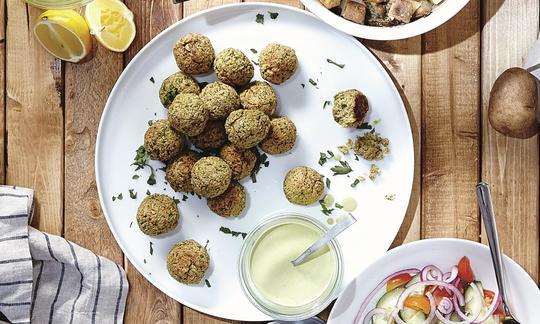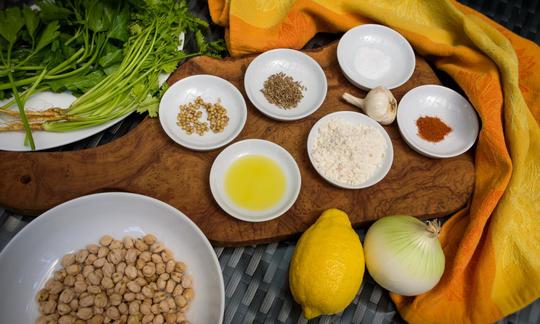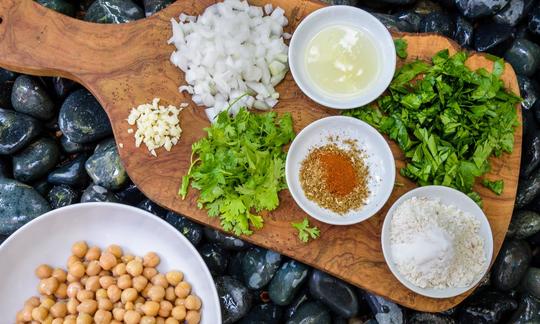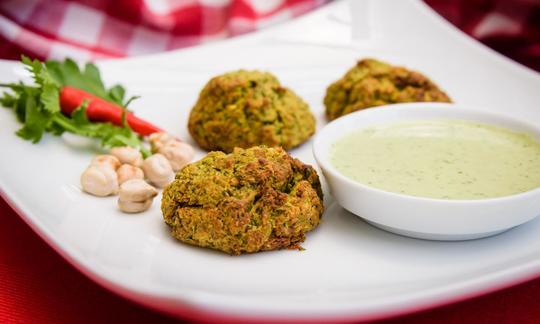Baked Green Falafel with Pea Protein by Terry Hope Romero
vegan
Ingredients (for servings, )
| Prepare the chickpeas | |
|---|---|
| 7 ⅓ oz | Chickpeas, raw (organic?) |
| For the baked green falafel | |
| 1 bunch | Parsley, fresh, raw (leaf parsley, parsley) (1.1 oz) |
| ½ bunch | Coriander leaves, raw (0.35 oz) |
| 4 cloves | Garlic (organic?) (0.42 oz) |
| 1 large | Onions, raw (organic?) (5.3 oz) |
| 1 ½ tsp | Coriander, seeds (raw?, organic?) (0.09 oz) |
| 2 tbsp | Lemon juice (raw?, organic?) (0.51 oz) |
| 1 tbsp | Olive oil (cold pressed, raw?, organic?) (0.47 oz) |
| 1 ½ tsp | Cumin, ground (raw, organic?) (0.16 oz) |
| ½ tsp | Cayenne pepper (raw?, organic?) (0.03 oz) |
| 1 dash | Salt, table salt (0.01 oz) |
| 1 tsp | Baking powder (baking agent, organic?, vegan?) (0.11 oz) |
| 2 ⅛ oz | Wheat flour, wholemeal (organic?) |
| To brush on the falafel | |
| 2 tbsp | Olive oil (cold pressed, raw?, organic?) (0.95 oz) |
Equipment
- blender or hand-held blender / immersion blender
- mortar
- citrus juicer (lemon squeezer)
- oven
- baking sheet (cookie sheet)
- sieve
Type of preparation
- bake
- chop or grind
- soak
- squeeze
- season to taste
- purée
- remove the skin
Preparation
Prepare the chickpeas
Cover the chickpeas with 3 inches of cold water and soak for 8 to 10 hours (overnight is perfect).Prepare the baked green falafel
After the chickpeas are finished soaking, drain them and discard the water.
Preheat the oven to 200 °C (400 °F) and line a large baking sheet with parchment paper.Chop the parsley and cilantro. Peel the garlic cloves and onion and then chop. In a food processor, grind the chickpeas with the parsley, cilantro, garlic, onion, olive oil, lemon juice, coriander, cumin, cayenne, salt, and baking powder into a thick, chunky paste. Add the flour little by little until it is completely mixed in. At this point, you should have a firm dough. The amounts of parsley and cilantro can vary in every bunch, so to make a thick dough you may need a little more or less flour.
The original recipe calls for ¾ teaspoon salt and 3 tablespoons olive oil for 4 servings. We have purposely reduced the amount of salt and olive oil and increased the amount of coriander and cumin to 1½ tablespoons each.
The author uses ½ teaspoon baking soda instead of baking powder.
High-protein version: Instead of flour, Terry Hope Romero uses 60 g pea protein powder. Add the pea protein powder and pulse until the powder is absorbed and the mixture is thick.
Taste and season with a little more salt and cayenne, if desired.
Scoop 2 tablespoon–size balls of the mixture onto the baking sheet.The author uses a medium-size mechanical cookie scoop for easy, neat scooping and shaping of falafel balls.
Terry Hope Romero recommends serving the falafel while they are still hot. Since the total preparation time for the falafel, including the baking time, is about 30 minutes you may want to begin by preparing the side dishes first. This way you will be sure to have fresh, hot falafel to serve.
Spray or brush each ball with olive oil and bake the falafel for 22 to 24 minutes, or until firm and the bottoms are golden brown.
|
Nutritional Information per person
Convert per 100g
|
2000 kcal | |
|---|---|---|
| Energy | 361 kcal | 18.1% |
| Fat/Lipids | 14 g | 20.1% |
| Saturated Fats | 1.8 g | 9.1% |
| Carbohydrates (inc.dietary fiber) | 49 g | 18.1% |
| Sugars | 7.3 g | 8.1% |
| Fiber | 9.2 g | 36.8% |
| Protein/Albumin | 13 g | 26.9% |
| Cooking Salt (Na:149.4 mg) | 379 mg | 15.8% |
| Essential micronutrients with the highest proportions | per person | 2000 kcal | |
|---|---|---|---|
| Vit | Folate, as the active form of folic acid (née vitamin B9 and | 306 µg | 153.0% |
| Min | Manganese, Mn | 1.8 mg | 89.0% |
| Vit | Vitamin K | 53 µg | 71.0% |
| Prot | Tryptophan (Trp, W) | 0.14 g | 55.0% |
| Prot | Threonine (Thr, T) | 0.46 g | 50.0% |
| Min | Copper, Cu | 0.45 mg | 45.0% |
| Prot | Phenylalanine (Phe, F) | 0.68 g | 44.0% |
| Prot | Isoleucine (Ile, I) | 0.53 g | 43.0% |
| Prot | Lysine (Lys, K) | 0.78 g | 42.0% |
| Elem | Phosphorus, P | 273 mg | 39.0% |
Detailed Nutritional Information per Person for this Recipe
The majority of the nutritional information comes from the USDA (US Department of Agriculture). This means that the information for natural products is often incomplete or only given within broader categories, whereas in most cases products made from these have more complete information displayed.
If we take flaxseed, for example, the important essential amino acid ALA (omega-3) is only included in an overarching category whereas for flaxseed oil ALA is listed specifically. In time, we will be able to change this, but it will require a lot of work. An “i” appears behind ingredients that have been adjusted and an explanation appears when you hover over this symbol.
For Erb Muesli, the original calculations resulted in 48 % of the daily requirement of ALA — but with the correction, we see that the muesli actually covers >100 % of the necessary recommendation for the omega-3 fatty acid ALA. Our goal is to eventually be able to compare the nutritional value of our recipes with those that are used in conventional western lifestyles.
| Essential fatty acids | per person | 2000 kcal |
|---|---|---|
| Linoleic acid; LA; 18:2 omega-6 | 2.5 g | 25.0% |
| Alpha-Linolenic acid; ALA; 18:3 omega-3 | 0.14 g | 7.0% |
| Essential amino acids | per person | 2000 kcal |
|---|---|---|
| Tryptophan (Trp, W) | 0.14 g | 55.0% |
| Threonine (Thr, T) | 0.46 g | 50.0% |
| Phenylalanine (Phe, F) | 0.68 g | 44.0% |
| Isoleucine (Ile, I) | 0.53 g | 43.0% |
| Lysine (Lys, K) | 0.78 g | 42.0% |
| Leucine (Leu, L) | 0.91 g | 37.0% |
| Valine (Val, V) | 0.55 g | 34.0% |
| Methionine (Met, M) | 0.18 g | 19.0% |
| Vitamins | per person | 2000 kcal |
|---|---|---|
| Folate, as the active form of folic acid (née vitamin B9 and | 306 µg | 153.0% |
| Vitamin K | 53 µg | 71.0% |
| Thiamine (vitamin B1) | 0.36 mg | 32.0% |
| Vitamin B6 (pyridoxine) | 0.43 mg | 31.0% |
| Vitamin C (ascorbic acid) | 18 mg | 23.0% |
| Vitamin E, as a-TEs | 2.2 mg | 18.0% |
| Pantothenic acid (vitamin B5) | 1.00 mg | 17.0% |
| Biotin (ex vitamin B7, H) | 6.8 µg | 14.0% |
| Riboflavin (vitamin B2) | 0.16 mg | 12.0% |
| Niacin (née vitamin B3) | 1.8 mg | 11.0% |
| Vitamin A, as RAE | 47 µg | 6.0% |
| Essential macroelements (macronutrients) | per person | 2000 kcal |
|---|---|---|
| Phosphorus, P | 273 mg | 39.0% |
| Potassium, K | 572 mg | 29.0% |
| Magnesium, Mg | 76 mg | 20.0% |
| Sodium, Na | 149 mg | 19.0% |
| Calcium, Ca | 84 mg | 11.0% |
| Essential trace elements (micronutrients) | per person | 2000 kcal |
|---|---|---|
| Manganese, Mn | 1.8 mg | 89.0% |
| Copper, Cu | 0.45 mg | 45.0% |
| Iron, Fe | 4.3 mg | 30.0% |
| Zinc, Zn | 2.1 mg | 21.0% |
| Selenium, Se | 10 µg | 18.0% |
| Iod, I (Jod, J) | 11 µg | 7.0% |
| Fluorine, F | 1.9 µg | < 0.1% |
Serve these baked green falafel balls by Terry Hope Romero as a main dish or with dip as a snack. The pea protein adds a nutritional punch.
Servings: This recipe makes about 24 falafel balls, enough for 4 servings.
Main dish or side dish: The number of servings in this recipe is based on the falafel being used as a side dish. However, you can easily turn it into the main dish. Some good additions to this would be a fresh, crisp salad, flavorful hummus, or homemade tomato sauce. Additional suggestions are listed under Alternative Preparation.
Falafel: Falafel is an integral part of Middle Eastern and North African cooking. This meatless source of protein, which is becoming increasingly popular around the globe, is considered ato be the national dish of Israel. You can make many different variations of this recipe by starting with the base ingredients of chickpeas, onions, garlic, and spices. This versatility is just one factor that makes it so popular among vegans and vegetarians. While it is often deep-fried, we recommend this healthier and low-fat baked version. You can also prepare falafel in a skillet.
Storing the falafel batter or falafel balls: If you want to make extra falafel batter or falafel balls or if you made more than you planned to, don’t worry — both the batter and the prepared falafel balls store well when tightly covered in the refrigerator. You can refrigerate the batter for up to five days without losing any flavor, while the falafel balls may lose some of their crispness.
Consistency of the falafel: The original recipe uses pea protein powder while our recipe calls for flour. To give your falafel more flavor, you can use chickpea or almond flour. For the best results, add the flour little by little until you reach the perfect balance between a dough that is soft enough to be formed into balls but stiff enough so that it won’t fall apart when cooked.
Quick version: Many recipes recommend using cooked (canned) chickpeas, which allows you to skip the soaking and cooking steps. When using cooked chickpeas, you can prepare this recipe in a little less than an hour. However, we feel that you will lose flavor as well as texture if you do this. You will need to adjust the amount of flour you use and recognize that you will lose the grainy texture that is so typical of this dish. The amount of chickpeas you use will also change because 100 g dried chickpeas is equivalent to 200 g cooked.
High-protein version: You can follow the original recipe for 4 servings and add pea protein powder instead of flour in Step 3. Add the pea protein powder and pulse until the powder is absorbed and the mixture is thickened.
Dip suggestions: Some suggestions for dips to go with the falafel are tzatziki (tzatziki with garlic mustard), vegan yogurt, or a fruity/savory tomato sauce such as tomato sauce with tamarind.
Suggested combinations: Serve the hot falafel as part of the recipe for Falafel Bowl with Lemon Roasted Potatoes, Basil Lemon Cashew Dressing, and Chopped Mediterranean Salad (“Protein Ninja,” p. 155). Try it with Lettuce Wraps with Fruity Mango Chutney, or with hummus, pita bread, and a fresh, crisp salad.









